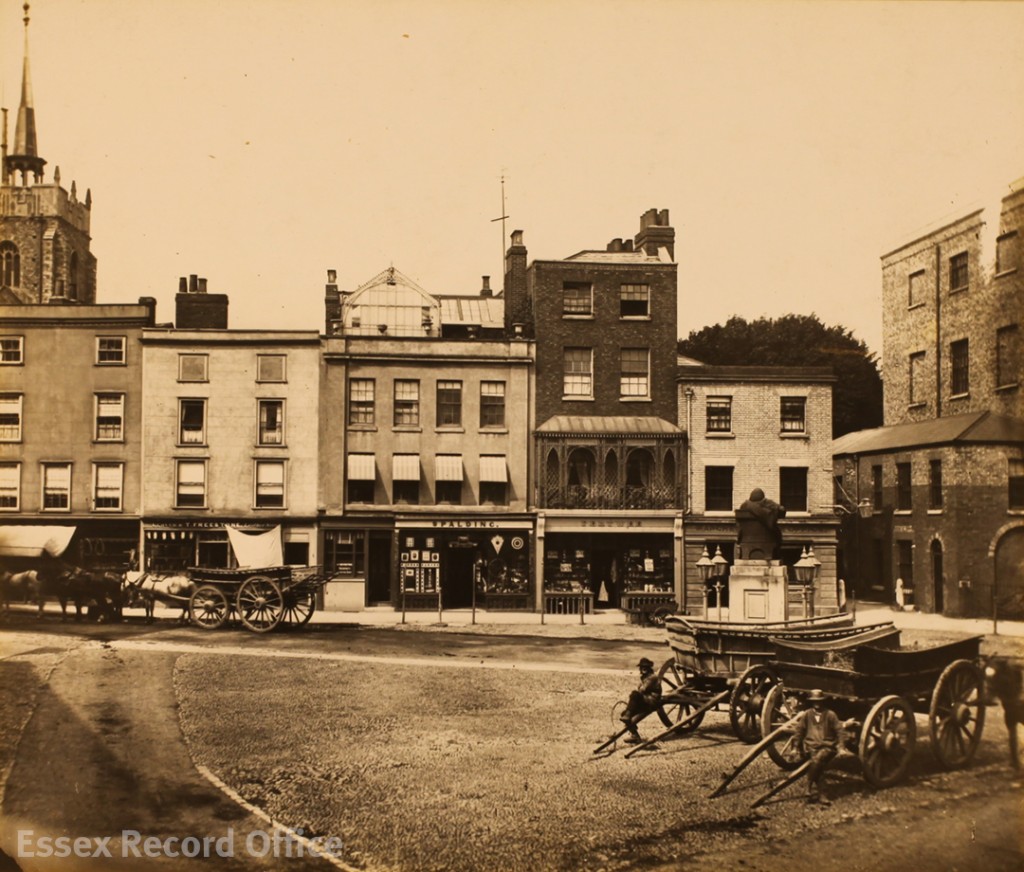We’re getting excited to share the creative side of our collections with visitors at our Heritage Open Day next week (Saturday 10 September 2016), including an insight into our most extensive photographic collection, the Spalding Collection. This collection includes some 7,000 images depicting 19th and 20th century Essex, created by three generations of the Spalding family, all of them named Fred.
Alongside a display of some of the Spalding images, we will have our very own digitiser and early photography expert Andy Morgan with a display of historic cameras, to explain how the photographs were taken.
The first Fred Spalding (1830-1895) took up the new art form of photography in the 1860s. Born in Danbury, Spalding was the fifth child of a shoemaker, and had several lines of business before becoming a professional photographer (in an 1859 directory he is listed as a ‘bird stuffer and furniture broker’). By 1862 he was listed as Chelmsford’s only photographer, mastering the complex equipment and chemical processes demanded by the early days of the pursuit.

Tindal Square, Chelmsford, in 1876, with the first Spalding shop in the centre. Spalding combined his photography business with a ‘fancy goods’ shop. To illuminate his portrait photographs with natural light, Spalding had a glass studio built on the roof, which can still be seen today. (D/Z 206/1/86)
At this stage Spalding would have been using the wet collodion method of photography, invented by Frederick Scott Archer in 1851. To create an image, a glass plate was coated with a mixture of collodion and potassium iodide, sensitized with a solution of silver nitrate, and then exposed for anything from a few seconds to several minutes. While still damp, the chemicals were fixed and developed, producing a negative image on the glass plate, which could then be used to produce a positive print. The whole process – from coating the plate to making the exposure to developing the negative – had to be completed within about 10-15 minutes, before the chemicals had time to dry.

Glass negatives on a lightbox. Some of the glass negatives in the Spalding collection are as large as 12×10 inches. Glass negatives can produce a wonderfully sharp image, but of course are extremely fragile.
This short Vine loop shows how we can use editing software such as Photoshop to turn an image taken from a glass negative into a positive image. This is a photograph of women at work in Marconi’s first factory in Hall Street, c.1900.

Fred Spalding’s earliest surviving view of the lower end of Chelmsford High Street, with Shire Hall visible in the distance, taken in the late 1860s on a glass plate using the wet collodion process. Taking a photograph outdoors using this process was extremely challenging. (D/F 269/1/3715)
Victorian photographers experimented with different printing processes from albumen paper, coated with egg white to the later gelatin silver prints introduced in the 1880s. The Spaldings used a variety of processes including carbon print and platinotype in a search to find a print that would not fade.

The largest print from the Spalding collection, with a pencil to give an idea of scale. It shows the Prince of Wales’s visit to Easton lodge near Great Dunmow in 1891, the home of his mistress, Daisy, Countess of Warwick. The prince is standing in the centre of the back row, with Daisy to his left.
Frederick Spalding junior (1858-1947) grew up immersed in the world of his father’s photography. In the early 1890s he moved the growing business to 4 Chelmsford High Street, next door to the Saracen’s Head Hotel, and built a reputation as a portrait, landscape, and commercial photographer.

Fred Spalding junior, photographed in his father’s studio in Tindal Square in the mid-1860s. (D/F 269/1/3719)
By 1891, Frederick Spalding junior was well-established in his Chelmsford ‘fancy goods’ shop and photography business. In addition to portrait, landscape and commercial photography, Spalding took a keen interest in Chelmsford’s history, and fought to save ancient parts of the town, documenting them through photographs as they disappeared. Several of his photographs display a creative flair for posing groups of people – here are two of our favourite striking images.

Chelmsford Borough Fire Brigade proudly demonstrate their new fire escape ladder against the side of Chelmsford’s Corn Exchange, May 1899. Until 1918 the Chelmsford Fire Brigade relied on horses to pull their fire engines. (I/Sp 15/350)

Jackson’s dairy farm at Wickford, early 1920s, when new hygiene rules were having an effect on cowmen’s clothing. Essex became the first county to hold a clean milk competition in 1920. (D/F 269/1/4492)
Join us at our Heritage Open Day, a celebration of creativity in the archives, on Saturday 10 September 2016 to see more from the Spalding Collection, and lots more. You can find all of the details here.

I have a number of “Spaldings” would they be of any interest??
Hi Iain, they may very well be, would you be able to contact us on ero.enquiry@essex.gov.uk or 03330132500?
Will be oit of the country on the 10th but would like to view collection if possible at another time. ?
Hi Iain, absolutely, they are available to view in our Searchroom – you can find out how to visit us here: http://essexrecordoffice.co.uk/visit-us/